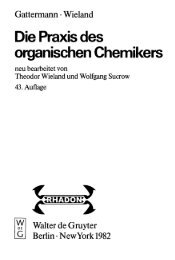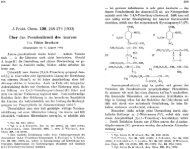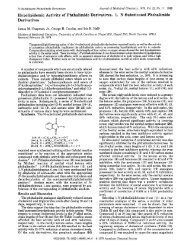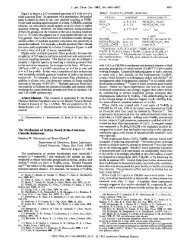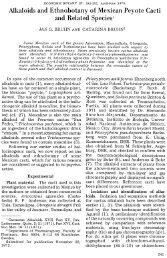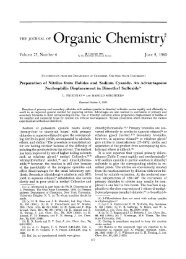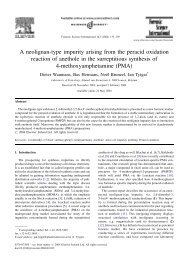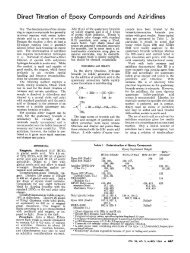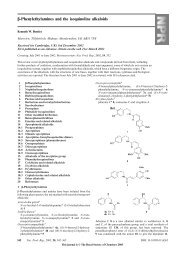Carbon-Heteroatom Bond-Forming Reactions Mediated by ... - mdma
Carbon-Heteroatom Bond-Forming Reactions Mediated by ... - mdma
Carbon-Heteroatom Bond-Forming Reactions Mediated by ... - mdma
You also want an ePaper? Increase the reach of your titles
YUMPU automatically turns print PDFs into web optimized ePapers that Google loves.
156<br />
<strong>Carbon</strong>-<strong>Heteroatom</strong> <strong>Bond</strong>-<strong>Forming</strong> <strong>Reactions</strong> <strong>Mediated</strong> <strong>by</strong> Cerium(IV)<br />
Ammonium Nitrate:An Overview<br />
<strong>Carbon</strong>-<strong>Heteroatom</strong> Vijay <strong>Bond</strong>-<strong>Forming</strong> <strong>Reactions</strong> <strong>Mediated</strong> <strong>by</strong> CAN Nair,* Sreeletha B. Panicker, Latha G. Nair, Tesmol G. George, Anu Augustine<br />
Organic Chemistry Division, Regional Research Laboratory (CSIR), Trivandrum-695 019, India<br />
Fax +91(471)491712; E-mail: gvn@csrrltrd.ren.nic.in<br />
Received 10 July 2002<br />
Abstract: As a powerful one-electron oxidant, cerium(IV) ammonium<br />
nitrate (CAN) is useful for a variety of oxidative transformations<br />
including carbon-carbon bond formation. Recent work has<br />
also demonstrated the usefulness of CAN in carbon-heteroatom<br />
bond-forming reactions. Particularly noteworthy is the effectiveness<br />
of CAN in building C–N, C–S, C–Se, C–Br, and C–I bonds.<br />
This account is aimed at creating awareness among organic chemists<br />
about such reactions with potential application in the synthesis<br />
of a variety of building blocks.<br />
1 Introduction<br />
2 <strong>Carbon</strong>-<strong>Carbon</strong> <strong>Bond</strong>-<strong>Forming</strong> <strong>Reactions</strong> <strong>Mediated</strong> <strong>by</strong><br />
CAN: A Brief Outline<br />
3 <strong>Carbon</strong>-<strong>Heteroatom</strong> <strong>Bond</strong>-<strong>Forming</strong> <strong>Reactions</strong> <strong>Mediated</strong> <strong>by</strong><br />
CAN<br />
3.1 <strong>Carbon</strong>-Nitrogen <strong>Bond</strong> Formation<br />
3.2 <strong>Carbon</strong>-Sulfur <strong>Bond</strong> Formation<br />
3.3 <strong>Carbon</strong>-Selenium <strong>Bond</strong> Formation<br />
3.4 <strong>Carbon</strong>-Halogen <strong>Bond</strong> Formation<br />
4 Conclusion<br />
Key words: cerium(IV) ammonium nitrate, radical reactions,<br />
bond-forming reactions, heteroatoms, oxidations<br />
1 Introduction<br />
Although radicals have been known since the ground<br />
breaking discovery <strong>by</strong> Gomberg in 1900, 1 and notwithstanding<br />
the pointers to their potential application in synthesis<br />
presented in the work of Hey and Waters, 2a<br />
Kharasch, 2b and Mayo, 2c no serious attempts to incorporate<br />
radical methodology in rational organic synthesis was<br />
made until the last quarter of the twentieth century. A paradigm<br />
shift, resulting in explosive growth in the area of<br />
radical methodology during the last two decades can be<br />
attributed in large measure to the conceptualization and<br />
demonstration <strong>by</strong> Stork that the controlled formation, as<br />
well as the addition of vinyl radicals to alkenes, constitutes<br />
a unique and powerful method for complex carbocyclic<br />
construction. 3 Important contributions made <strong>by</strong> many<br />
research groups, most notably those of Julia, 4 Beckwith, 5<br />
Giese, 6 Ingold, 7 Curran 8 and Pattenden 9 have also contributed<br />
immensely to the general acceptance of radical methodology.<br />
As an integral part of this rapidly growing area<br />
of organic synthesis, 3–9 the application of carbon centered<br />
Synlett 2003, No. 2, 31 01 2003. Article Identifier:<br />
1437-2096,E;2002,0,02,0156,0165,ftx,en;A29201ST.pdf.<br />
© Georg Thieme Verlag Stuttgart · New York<br />
ISSN 0936-5214<br />
ACCOUNT<br />
radicals resulting from redox processes mediated <strong>by</strong> highvalent<br />
metal salts such as Mn(III), Co(III), V(V), Ce(IV)<br />
etc has emerged as a powerful tool for carbon-carbon<br />
bond-formation in recent years. 10<br />
The use of Ce(IV) reagents as convenient oxidants for a<br />
variety of substrates is well established; 10a,11 their use in<br />
carbon-carbon bond-forming reactions was demonstrated<br />
<strong>by</strong> Heiba and Dessau as early as 1971. 12 Subsequent investigations<br />
have shown that Ce(IV) reagents, especially<br />
cerium(IV) ammonium nitrate (CAN) are powerful oneelectron<br />
oxidants, which are useful for various synthetic<br />
transformations. 10c,13 Comparative studies have shown<br />
that in intermolecular reactions, CAN is superior to the<br />
more commonly used Mn(III) acetate in many respects. 14<br />
The experimental simplicity, ease of handling and nontoxicity<br />
combined with its solubility in organic solvents<br />
like MeOH and MeCN, has made CAN attractive in organic<br />
synthesis. The use of CAN in carbon-carbon bondforming<br />
reactions is now well documented13 and it is noteworthy<br />
that there has been a flurry of activity in this area<br />
since our original review appeared. 15 Interestingly, there<br />
has also been considerable effort towards exploring the<br />
use of CAN in C-heteroatom bond-formation. This account<br />
focuses on the recent progress in CAN-mediated reactions<br />
involving carbon-nitrogen, carbon-sulfur, carbonselenium<br />
and carbon-halogen bond formation, highlighting<br />
the results of our own investigations in this area. To<br />
put things in perspective, a brief account of the use of<br />
CAN in carbon-carbon bond formation is given as a prelude.<br />
2 <strong>Carbon</strong>-<strong>Carbon</strong> <strong>Bond</strong>-<strong>Forming</strong> <strong>Reactions</strong><br />
<strong>Mediated</strong> <strong>by</strong> CAN: A Brief Outline<br />
It is evident from the literature that there has been considerable<br />
recent interest in the use of Ce(IV) reagents especially<br />
CAN in the construction of carbon-carbon bonds. 15<br />
As might be expected of a very powerful one-electron oxidant,<br />
oxidation of organic molecules <strong>by</strong> CAN is dominated<br />
<strong>by</strong> radical and cation radical chemistry. Oxidative<br />
additions of electrophilic radicals to alkenes, 16 enol<br />
ethers, 17 dienes, 18 glycals, 19 and allyl silanes 20 are representative<br />
of the many reports on the use of CAN in carbon-carbon<br />
bond-forming reactions. Nitromethylation, 21<br />
malonylation, 22 and acetonylation 23 of arenes were also<br />
reported earlier.
ACCOUNT Stereoselective Synthesis of Cyclic Ethers and Amines <strong>by</strong> Cyclization of Vinylsilanes 157<br />
Biographical Sketches<br />
Vijay Nair was born and<br />
raised in Konni, Kerala<br />
state, India. He has PhD degrees<br />
from Banaras Hindu<br />
University (with Professor<br />
R. H. Sahasrabudhey) and<br />
the University of British Columbia<br />
(with Professor<br />
James P. Kutney). He has<br />
done post-doctoral work<br />
with Josef Fried (Chicago),<br />
Peter Yates (Toronto) and<br />
Gilbert Stork (Columbia).<br />
He joined the Medical Research<br />
Division (Lederle<br />
Laboratories) of American<br />
Cyanamid Company as Senior<br />
Research Chemist in<br />
Sreeletha B. Panicker was<br />
born in Alappuzha, Kerala<br />
state, India. She is a Gold<br />
Medallist of Kerala University<br />
(BSc) and she received<br />
her MSc in Chemistry from<br />
Mahatma Gandhi Univer-<br />
Latha G. Nair was born<br />
in Kuruppanthara, Kerala<br />
state, India and received her<br />
BSc and MSc (St. Thomas<br />
College, Pala) in Chemistry<br />
from Mahatma Gandhi University.<br />
She received her<br />
PhD (1999, Kerala Univer-<br />
Tesmol G. George was<br />
born in Pala, Kerala state,<br />
India. She received her BSc<br />
and MSc in Chemistry (St.<br />
Thomas College, Pala) from<br />
Mahatma Gandhi University.<br />
She received her PhD<br />
(2000, Cochin University of<br />
Anu Augustine was born in<br />
Pala, Kerala state, India.<br />
She received her BSc and<br />
MSc in Chemistry (St. Thomas<br />
College, Pala) from<br />
Mahatma Gandhi Universi-<br />
1974 and became Principal<br />
Research Chemist in 1987.<br />
In 1981 he received the Outstanding<br />
Scientist Award of<br />
Cyanamid Company. In<br />
1990, he returned to India to<br />
join the Regional Research<br />
Laboratory (CSIR) in<br />
Trivandrum as its Deputy<br />
Director. During 1997–<br />
2001, Dr Nair was the Director<br />
of the Laboratory and<br />
presently he is continuing as<br />
Director-grade Scientist. He<br />
has lectured in a number of<br />
Universities in Germany in<br />
1998 under the INSA–DFG<br />
exchange fellowship. He<br />
sity. She obtained her PhD<br />
degree (2001, Kerala University)<br />
working under the<br />
supervision of Dr Vijay Nair<br />
at the Regional Research<br />
Laboratory (CSIR), Trivandrum.<br />
She is currently an<br />
sity) working under the supervision<br />
of Dr Vijay Nair<br />
at the Regional Research<br />
Laboratory (CSIR), Trivandrum.<br />
Subsequently, she<br />
was a post-doctoral fellow<br />
with Professor Bert Fraser-<br />
Reid at N. P. G. Research<br />
Science and Technology)<br />
working under the supervision<br />
of Dr Vijay Nair at the<br />
Regional Research Laboratory<br />
(CSIR), Trivandrum.<br />
During the period 2001–<br />
2002, she was a post-doctoral<br />
fellow at ETH Zürich in<br />
ty. She received her Ph.D.<br />
(2002, Kerala University)<br />
working under the supervision<br />
of Dr Vijay Nair at the<br />
Regional Research Laboratory<br />
(CSIR), Trivandrum.<br />
has been an Invited Speaker<br />
at the 17 th ICHC in Vienna<br />
in 1999 and the MCR 2000,<br />
International Symposium in<br />
Munich. He was a Visiting<br />
Professor at the University<br />
of Pernambuco in Brazil in<br />
May 2001. Dr Nair is a Fellow<br />
of the Indian Academy<br />
of Sciences. His research interests<br />
include cycloadditions,<br />
radical-mediated C–C<br />
and C–heteroatom bondforming<br />
reactions, multicomponent<br />
reactions and<br />
heterocyclic synthesis.<br />
Alexander von Humboldt<br />
post-doctoral fellow in the<br />
group of Professor Dr. H.<br />
M. R. Hoffmann at the University<br />
of Hannover, Germany.<br />
Institute, Raleigh, NC,<br />
USA. She is currently working<br />
as a Senior Scientist at<br />
Schering–Plough Research<br />
Institute, Kenilworth, NJ,<br />
USA.<br />
the research group of Professor<br />
Dr. Andrea Vasella.<br />
Currently she is a postdoctoral<br />
fellow with Professor<br />
Dr. Albert Eschenmoser<br />
at Sripps Institute in San<br />
Diego, U.S.A.<br />
Currently she is a post-doctoral<br />
fellow at ETH Zürich<br />
in the research group of Professor<br />
Dr. Andrea Vasella.<br />
Synlett 2003, No. 2, 156–165 ISSN 0936-5214 © Thieme Stuttgart · New York
158 V. Nair et al. ACCOUNT<br />
Investigations in our laboratory have revealed that oxidative<br />
addition of 1,3-dicarbonyl compounds to alkenes, 24<br />
dienes, 25 and exocyclic alkenes26 provides a facile synthesis<br />
of dihydrofuran and spirodihydrofuran derivatives. An<br />
interesting and mechanistically fascinating reaction was<br />
observed in the oxidative addition of malonate to styrenes.<br />
27 We have reported the CAN mediated single electron<br />
transfer reaction (SET) of methoxy styrenes yielding<br />
dimerization products via the intermediacy of cation radicals.<br />
28 Very recently, we have reported a facile one-pot<br />
synthesis of 1-amino 4-aryl tetralin derivatives <strong>by</strong> the<br />
CAN-induced cyclodimerization of various styrenes. 29<br />
In comparison to Mn(III)acetate, there are very few<br />
reports on intramolecular cyclization reactions induced<br />
<strong>by</strong> (CAN). 30,31 The CAN mediated Pictet–Spengler cyclization32<br />
and cyclization of a-methoxycarbonyl acetyl<br />
enamides and acetoacetyl enamides leading to highly<br />
functionalized b-lactams33 are noteworthy in this context.<br />
Very recently, we have reported that the intramolecular<br />
cyclization of cinnamyl ethers using CAN results in the<br />
stereospecific formation of 3,4-trans disubstituted tetrahydrofuran<br />
derivatives. 34<br />
3 <strong>Carbon</strong>-<strong>Heteroatom</strong> <strong>Bond</strong>-<strong>Forming</strong><br />
<strong>Reactions</strong> <strong>Mediated</strong> <strong>by</strong> CAN<br />
All CAN-mediated reactions, in general, can be broadly<br />
classified into two categories. The first one involves the<br />
formation of a cation radical <strong>by</strong> the oxidation of the substrate<br />
and subsequent transformations mediated <strong>by</strong> the<br />
cation radical. Since almost all these reactions involve incorporation<br />
of the solvent, carbon heteroatom bond formation<br />
is common to them. The second category involves<br />
the addition of heteroatom-centered radicals, formed <strong>by</strong><br />
the oxidation of the anions <strong>by</strong> CAN, to alkenes or alkynes;<br />
this review is focused on such reactions.<br />
3.1 <strong>Carbon</strong>-Nitrogen <strong>Bond</strong> Formation<br />
3.1.1 Introduction of Azide Functionality<br />
Apart from the CAN-mediated reactions in which solvent<br />
incorporation results in carbon-heteroatom bond formation,<br />
the first example of such a reaction using an added<br />
nucleophile was reported <strong>by</strong> Trahanovsky in 1971. 35<br />
Trapping of azide radicals, generated <strong>by</strong> the oxidation of<br />
sodium azide with CAN in MeCN, <strong>by</strong> olefins such as hexene,<br />
stilbene and acenaphthalene resulted in the formation<br />
of trans-a-azido-b-nitratoalkanes (Scheme 1).<br />
Scheme 1<br />
i. NaN 3, CAN,<br />
MeCN, r.t.<br />
i<br />
O 2NO N 3<br />
1 (90%)<br />
Synlett 2003, No. 2, 156–165 ISSN 0936-5214 © Thieme Stuttgart · New York<br />
The mechanism suggested for this reaction involves the<br />
addition of azide radical or the cerium-azide complex to<br />
the alkene. The reaction was reported to have failed with<br />
a,b-unsaturated carbonyl compounds (vide infra). With<br />
sterically hindered olefins only 1,2-diazides were formed<br />
in very low yields. 36<br />
Since the initial report on azidonitration using CAN <strong>by</strong><br />
Trahanovsky, the method has been widely used for functionalization<br />
of double bonds, especially in carbohydrates<br />
as exemplified <strong>by</strong> the reaction of 3,4,6-tri-O-acetyl-D-galactal<br />
with excess CAN and sodium azide in MeCN yielding<br />
the 2-azido-1-nitrate (Scheme 2). 37<br />
AcO<br />
OAc<br />
Scheme 2<br />
A drawback of this reaction is that a large excess of CAN<br />
and sodium azide are needed to compensate for the loss<br />
due to oxidation of azide to nitrogen gas. Evidently, the<br />
acetamido product is formed <strong>by</strong> Ritter trapping of the carbocation<br />
<strong>by</strong> MeCN and hydration of the resulting iminium<br />
ion.<br />
It is noteworthy that the non-nucleophilicity, acid tolerance<br />
and ease of reduction of azide to amine, makes the<br />
introduction of azide group a very important process in<br />
the synthesis of amino sugars. The importance of the reaction<br />
is evinced <strong>by</strong> the application of this or related processes<br />
discernible in the literature. 38<br />
Recently, the oxidative azidation of triisopropylsilyl enol<br />
ethers has been used for the synthesis of a-azido ketones<br />
<strong>by</strong> Magnus (Scheme 3). 39<br />
Me<br />
Scheme 3<br />
OAc<br />
O<br />
i. NaN3, CAN,<br />
MeCN, H 2O<br />
OSi( i Pr) 3<br />
AcO<br />
AcO<br />
AcO<br />
AcO<br />
i NaN 3, CAN, MeCN,<br />
argon, –20 °C<br />
i<br />
i<br />
OAc<br />
AcO<br />
OAc<br />
N3 O ONO2<br />
+ AcO<br />
N3 O<br />
2 (53%) 3 (8%) ONO2 N3<br />
OAc<br />
It may be mentioned that in earlier work, Vogel has used<br />
this method as an intermediate step in the total synthesis<br />
of deoxypolyoxin. 40 CAN-mediated azidonitration has<br />
also been applied in the synthesis of amino acids<br />
(Scheme 4). 41 CAN-mediated azidation of enol ethers has<br />
been reported to afford azido acetals. 42<br />
O<br />
4 (10%)<br />
NHAc<br />
+<br />
AcO<br />
AcO<br />
N3<br />
5 (22%)<br />
O<br />
Me N3<br />
6 (72%)<br />
OAc<br />
O<br />
ONO2
ACCOUNT Stereoselective Synthesis of Cyclic Ethers and Amines <strong>by</strong> Cyclization of Vinylsilanes 159<br />
R<br />
Scheme 4<br />
In the azidonitration and diazidation of styrenes, reported<br />
<strong>by</strong> Trahanovsky, the solvent used was MeCN. 35 Recently,<br />
we observed a remarkably different reactivity in methanol.<br />
The reaction of styrene with sodium azide and CAN<br />
in methanol illustrates this; the azidomethyl ether was<br />
formed as the major product along with smaller amounts<br />
of the azido nitrate and the azido ketone (Scheme 5). 43<br />
R<br />
Scheme 5<br />
In an oxygen atmosphere, the azido ketone was formed<br />
exclusively (Scheme 6). 43<br />
Scheme 6<br />
R<br />
OMe i<br />
N3 CN<br />
i. NaN3, CAN<br />
7<br />
ONO2 OMe<br />
CN<br />
i. NaN 3, CAN, MeOH,<br />
argon, 0 °C<br />
R R<br />
i. NaN3, CAN, MeOH,<br />
oxygen, 0 °C, 45 min<br />
i<br />
i<br />
H2N<br />
CO 2H<br />
Mechanistically, the reaction can be conceived to involve<br />
the addition of azide radical, formed <strong>by</strong> the oxidation of<br />
azide anion <strong>by</strong> CAN, to styrene generating a benzylic radical.<br />
The latter reacts either with molecular oxygen to give<br />
the phenacyl azide 10 via the intermediacy of a peroxy<br />
radical, or gets converted to the nitrato product <strong>by</strong> ligand<br />
transfer from CAN. The oxidation of the benzylic radical<br />
to the cation and its subsequent reaction with methanol<br />
leads to azidomethyl ether 9.<br />
Earlier workers have reported that CAN-mediated azidation<br />
fails with a,b-unsaturated carbonyl compounds. 35<br />
Contrary to these, we have observed a facile CAN-mediated<br />
addition of azide to such systems. Cinnamic acids,<br />
esters and cinnamamides on treatment with sodium azide<br />
and CAN in MeCN under deoxygenated conditions, afforded<br />
the corresponding a-azido-b-nitrato compounds in<br />
X<br />
+<br />
N3<br />
R R<br />
9a–f<br />
9a R = H, X = OMe (50%)<br />
9b R = H, X = ONO2 (28%)<br />
9c R = Me, X = OMe (14%)<br />
9d R = Me, X = ONO2 (41%)<br />
9e R = OAc, X = OMe (42%)<br />
9f R = OAc, X = ONO2 (31%)<br />
O<br />
10a–g<br />
10a R = H (85%)<br />
10b R = Me (76%)<br />
10c R = OAc (75%)<br />
10d R = Cl (69%)<br />
10e R = NO2 (68%)<br />
10f R = NHAc (68%)<br />
10g R = OMe (95%)<br />
N 3<br />
R<br />
8<br />
10a–c<br />
O<br />
N3<br />
10a R = H (15%)<br />
10b R = Me (14%)<br />
10c R = OAc (22%)<br />
excellent yields. 44 An illustrative example involves the reaction<br />
of ethyl cinnamate with sodium azide and CAN in<br />
MeCN under an argon atmosphere leading to the corresponding<br />
a-azido-b-nitrate in good yield (Scheme 7).<br />
R 3<br />
Scheme 7<br />
Further studies in our laboratory have shown that, sequential<br />
treatment of cinnamic esters and a,b-unsaturated ketones<br />
with sodium azide and CAN in MeCN followed <strong>by</strong><br />
sodium acetate in dry acetone yielded the corresponding<br />
a-azido cinnamates and a-azido-a,b-unsaturated ketones<br />
respectively in good yield (Scheme 8). 44<br />
R 3<br />
Scheme 8<br />
Similarly, cinnamic acids can be converted to b-azido<br />
styrenes (Scheme 9). 44<br />
Scheme 9<br />
Epoxides on treatment with catalytic amount of CAN and<br />
sodium azide in tert-butanol underwent oxidative ringopening<br />
to afford 1,2-azido alcohols. 45 The reaction is<br />
highly regioselective (Scheme 10).<br />
Scheme 10<br />
R 1<br />
CO 2R 4<br />
R2 i. NaN3, CAN, MeCN,<br />
argon, 0 °C, 1–3 h<br />
R 2<br />
R 1<br />
COR 4<br />
i. NaN3, CAN, MeCN, argon,<br />
0 °C-rt, 2 h<br />
ii. CH 3CO 2Na, acetone, rt, 1 h<br />
R 2<br />
i<br />
i, ii<br />
ONO 2<br />
N3<br />
R1 CO 2R 4<br />
R2 11a R1 = R2 = R3 = H, R4 = Me (75%)<br />
11b R1 = R2 = R3 = H, R4 = Et (73%)<br />
11c R1 = R2 = H, R3 = R4 = Me (86%)<br />
11d R1 = R2 = H, R3 =Cl, R4 = Et (69%)<br />
11e R1 = Cl, R2 = R3 = H, R4 = Et (62%<br />
11f R1 = R3 = H, R2 = OMe, R4 11a–f<br />
= Et (74<br />
Synlett 2003, No. 2, 156–165 ISSN 0936-5214 © Thieme Stuttgart · New York<br />
R 3<br />
R 3<br />
R 2<br />
N3<br />
R1 12a–f<br />
COR 4<br />
12a R 1 = R 2 = R 3 = H, R 4 = Me (65%)<br />
12b R 1 = R 2 = H, R 3 = R 4 = Me (66%)<br />
12c R 1 = R 3 = H, R 2 = OMe, R 4 = Me (76<br />
12d R 1 = R 2 = H, R 3 = Cl, R4 = Me (60%)<br />
12e R 1 = R 2 = R 3 = H, R 4 = Ph (72%)<br />
12f R 1 = R 2 = H, R 3 = Cl, R 4 = Ph (67%)<br />
CO2H N3<br />
i, ii<br />
R1 R3 R3 i. NaN3, CAN, MeCN, 0 °C,<br />
r.t., argon, overnight<br />
ii.CH 3CO 2Na, acetone,<br />
reflux, 2 h<br />
Ph<br />
R 2<br />
R 1<br />
13a–d<br />
13a R 1 = R 2 = R 3 = H (61%)<br />
13b R 1 = R 2 = H, R 3 = Me (65%<br />
13c R 1 = R 3 = H, R 2 = OMe (64%<br />
13d R 1 = R 2 = H, R 3 = Cl (39%)<br />
O<br />
i<br />
Ph<br />
N3 OH +<br />
Ph<br />
OH<br />
i. NaN3, CAN, t-BuOH, reflux<br />
14<br />
65% (98:2)<br />
15<br />
N3
160 V. Nair et al. ACCOUNT<br />
3.1.2 Introduction of Nitro Functionality<br />
Nitro compounds are important intermediates in organic<br />
synthesis and recently CAN has been used for the introduction<br />
of nitro group into a variety of substrates. Hwu et<br />
al. have reported that alkenes on treatment with an excess<br />
of sodium nitrite in the presence of CAN and acetic acid<br />
in chloroform in a sealed tube under sonication afforded<br />
nitroalkenes (Scheme 11). 46<br />
i. NaNO2, CAN, AcOH,<br />
CHCl 3, 25–73 °C<br />
Scheme 11<br />
It was speculated that the nitrous acid formed from sodium<br />
nitrite under acidic conditions is the source of nitrite<br />
radical. The latter on addition to the alkene generates a<br />
carbon radical, which undergoes oxidation <strong>by</strong> CAN and<br />
subsequent elimination of a proton leading to the formation<br />
of the nitroalkene. In order to increase the concentration<br />
of nitrite radical, the reaction is done in sealed<br />
tube. When the solvent is MeCN, a novel one-pot nitroacetamidation<br />
occurs (Scheme 12). 47<br />
i. NaNO2, CAN,<br />
MeCN, rt<br />
Scheme 12<br />
It is evident that quenching of the cationic intermediate <strong>by</strong><br />
MeCN in a Ritter fashion and subsequent transformation<br />
of the iminium ion leads to the acetamido product. With<br />
styrene and cinnamyl acetate, however, the product is bnitro<br />
styrene. Attempted nitroacetamidation of cyclopentene<br />
carboxaldehyde, under similar reaction conditions,<br />
resulted in the formation of the unexpected dinitro-oxime;<br />
the mechanism of this transformation is unclear<br />
(Scheme 13). 48<br />
Scheme 13<br />
i<br />
i<br />
CHO<br />
HO<br />
N<br />
i<br />
i. NaNO 2, CAN,<br />
MeCN, rt<br />
16 (90%)<br />
NO 2<br />
NO 2<br />
NHCOCH3 17 (64%)<br />
18 (21%)<br />
NO2 NO2 3.1.3 Nitration of Aromatic Nucleus<br />
Silica gel-supported CAN has been shown to nitrate polynuclear<br />
aromatic systems. 49,50 CAN-mediated nitration<br />
of naphthalene in presence of catalytic amount of H2SO4 and tert-butylammonium nitrite in methanol, afforded<br />
1-nitro-4-methoxynaphthalene as the major product<br />
(Scheme 14). 51<br />
Synlett 2003, No. 2, 156–165 ISSN 0936-5214 © Thieme Stuttgart · New York<br />
i. Bu 4NNO 2, CAN,<br />
H 2SO4, MeOH<br />
Scheme 14<br />
The suggested mechanistic rationale for this reaction involves<br />
the addition of nitrite radical to naphthalene and<br />
oxidation of the resulting radical to the cation followed <strong>by</strong><br />
methanol quenching.<br />
3.2 <strong>Carbon</strong>-Sulfur <strong>Bond</strong> Formation<br />
3.2.1 Sulfonylation<br />
Oxidation of sulfinates using one-electron oxidants, especially<br />
CAN provides an easy way to generate sulfonyl<br />
radicals, which otherwise would require photolytic conditions<br />
or action of peroxides. Narasaka has extensively<br />
studied the addition of sulfinate to various olefins, especially<br />
electron-rich ones in the presence of different oneelectron<br />
oxidants such as manganese(III) 2-pyridine carboxylate<br />
[Mn(pic) 3], tetrabutyl ammonium cerium(IV) nitrate<br />
(TBACN) and CAN. 52 An illustrative example is the<br />
reaction of sodium-2-naphthalenesulfinate with 1-vinylcyclobutanol<br />
in the presence of CAN in MeCN resulting<br />
in the formation of ring enlarged product (Scheme 15). 52<br />
Me<br />
HO<br />
Scheme 15<br />
We have observed that CAN-mediated oxidative addition<br />
of sulfinates to styrene proceeds very efficiently to afford<br />
keto and nitrato sulfinates (Scheme 16). 53<br />
Scheme 16<br />
i<br />
i<br />
OMe<br />
OMe<br />
NO2<br />
19 (70%) 20 (15%)<br />
O<br />
NO 2<br />
When sodium iodide is present in the reaction medium,<br />
vinyl sulfones are formed (Scheme 17). 54<br />
It is speculated that the vinyl sulfones are formed via the<br />
dehydroiodination of the intermediate iodovinyl sulfones.<br />
The formation of iodovinyl sulfones from alkynes under<br />
similar reaction conditions indirectly supports this postulate<br />
(Scheme 18). 54<br />
+<br />
Me SO2Nap<br />
i. NapSO2Na, CAN, 21 (72%)<br />
MeCN, 0 °C Nap = 2-Naphthyl<br />
i. ArSO 2Na, CAN,<br />
MeCN, r.t., 45 min<br />
i<br />
ONO2 SO2Ar<br />
+<br />
22 (61%) 23 (20%)<br />
O<br />
SO 2Ar
ACCOUNT Stereoselective Synthesis of Cyclic Ethers and Amines <strong>by</strong> Cyclization of Vinylsilanes 161<br />
R 3<br />
R 2<br />
Scheme 17<br />
Scheme 18<br />
3.2.2 Thiocyanation<br />
Thiocyanation of arenes and olefins constitutes an important<br />
method for introducing sulfur functionality into a<br />
molecule. Treatment of an alkene with ammonium thiocyanate<br />
and CAN in MeCN at ice cold temperature results<br />
in the formation of dithiocyanates in excellent yields. The<br />
reaction is general; the product yield ranges from 50–95%<br />
(Scheme 19). 55<br />
Scheme 19<br />
A different reactivity pattern leading to the phenacyl thiocyanate<br />
as the principal product was observed in methanol<br />
(Scheme 20). 43<br />
Scheme 20<br />
R 1<br />
i. p-TolSO2Na, NaI, CAN,<br />
MeCN, argon, r.t., 45 min<br />
i<br />
SO 2Tol<br />
R3 R2 R1 24a R1 = R2 = R3 = H (82%)<br />
24b R1 = R2 = H, R3 = Me (83%<br />
24d R1 = R2 = H, R3 = Cl (88%)<br />
24c R1 = R2 = H, R3 = OAc (72%<br />
24e R1 = R3 = H, R2 24a–e<br />
= NO2 (80%<br />
R1 R2 R3 R1 R2 R3 SO2Tol<br />
25a R1 = R2 = R3 = H (78%)<br />
25b R1 = R2 = H, R3 = Me (79%)<br />
25c R1 = R2 = H, R3 =OMe (75%<br />
25d R1 = R3 = H , R2 = OMe (65<br />
25e R1 = R3 = H, R2 i. p-TolSO2Na, NaI, CAN,<br />
25a–e<br />
MeCN, argon, r.t., 45 min<br />
= NO2 (65%<br />
R R<br />
i. NH4SCN, CAN,<br />
MeCN, r.t., 15 min<br />
i. NH4SCN, CAN,<br />
MeOH, r.t.<br />
i<br />
i<br />
i<br />
In an atmosphere saturated with oxygen, the predominant<br />
product is the phenacyl thiocyanate (Scheme 21). 43<br />
I<br />
SCN<br />
H<br />
26a–c<br />
26a R = H (95%)<br />
26b R = Me (75%)<br />
26c R = OMe (65%)<br />
O<br />
SCN<br />
SCN<br />
SCN<br />
SCN<br />
+<br />
27a (60%) 26a(10%)<br />
R R<br />
i. NH 4SCN, CAN, MeOH,<br />
O 2, 30 min, 0 °C<br />
Scheme 21<br />
In the case of vinyl naphthalene, in addition to the dithiocyanate,<br />
nitratothiocyanate is formed as a <strong>by</strong>product in<br />
low yield. With 4-acetoxystyrene, gem-dithiocyanates are<br />
also isolated. 43<br />
The same combination of reagents effects the thiocyanation<br />
of indole and substituted indoles (Scheme 22) 56<br />
Scheme 22<br />
Pyrroles and thiophene also undergo thiocyanation at 3position<br />
on treatment with CAN and ammonium thiocyanate.<br />
57 1,3-Dienes, on reaction with CAN and ammonium<br />
thiocyanate in MeCN afforded the corresponding 1,4dithiocyanates<br />
and in some cases the dithiocyanates<br />
formed underwent [3,3] sigmatropic rearrangement affording<br />
the isothiocyanato-thiocyanates (Scheme 23). 57<br />
Scheme 23<br />
i<br />
SCN<br />
3.3 <strong>Carbon</strong>-Selenium <strong>Bond</strong> Formation<br />
Introduction of phenylseleno group into an organic molecule<br />
is of great synthetic importance. The common reagents<br />
for such transformations are phenylselenenylbromide<br />
and phenylselenenylchloride. Oxidation<br />
of diphenyl diselenide to the cation radical using<br />
Synlett 2003, No. 2, 156–165 ISSN 0936-5214 © Thieme Stuttgart · New York<br />
O<br />
27a–f<br />
27a R = H (85%)<br />
27b R =OAc (68%)<br />
27c R = NO 2 (57%)<br />
27d R = OMe (53%)<br />
27e R = Cl (65%)<br />
27f R = NHAc (57%)<br />
R<br />
N N<br />
2 i<br />
R 1<br />
i. NH 4SCN, CAN,<br />
MeOH, r.t., 15 min<br />
i. NH4SCN, CAN, MeCN,<br />
0 °C, 30 min<br />
i<br />
i<br />
SCN<br />
i. NH4SCN, CAN, MeCN,<br />
0 °C, 30 min<br />
28a–d<br />
SCN<br />
R 1<br />
R 2<br />
28a R 1 = R 2 = H (100%)<br />
28b R 1 =Me, R 2 = H (99%)<br />
28c R 1 = H, R 2 = Me (84%)<br />
28d R 1 = H, R 2 = Ph (86%)<br />
SCN<br />
SCN<br />
29 (44%)<br />
SCN SCN<br />
+ +<br />
NCS<br />
SCN<br />
SCN<br />
30 (14%) 31 (15%) 32 (35%)
162 V. Nair et al. ACCOUNT<br />
CAN and subsequent trapping of the latter with olefins in<br />
MeOH leads to b-methoxyalkyl phenyl selenides in excellent<br />
yields (Scheme 24). 58 The reaction with trisubstituted<br />
olefins or enol ethers is highly regioselective, always<br />
leading to Markovnikov orientation.<br />
i. PhSeSePh, CAN, MeOH<br />
Scheme 24<br />
With 5-hexene-2-ol, intramolecular reaction afforded the<br />
selenide substituted tetrahydrofuran (Scheme 25). 58<br />
Scheme 25<br />
We have observed that the oxidative addition of selenocyanates<br />
to alkenes constitutes a highly efficient method for<br />
the synthesis of diselenocyanates and keto selenocyanates<br />
(Scheme 26). 59<br />
Scheme 26<br />
i<br />
SePh<br />
OMe<br />
33 (91%)<br />
OH OH<br />
Me<br />
Me<br />
i. KSeCN, CAN, MeOH,<br />
0°C, 30 min<br />
i<br />
SeCN<br />
+<br />
SeCN<br />
Me<br />
SeCN<br />
35a (60%) 36a (20%)<br />
The reaction can be forced in the desired direction to get<br />
either of the two products, simply <strong>by</strong> changing the reaction<br />
conditions. In a completely deoxygenated atmosphere,<br />
the diselenocyanate is formed exclusively whereas<br />
under oxygen saturated conditions, the phenacyl selenocyanate<br />
is formed as the sole product (Scheme 27). 59<br />
Scheme 27<br />
SeCN<br />
SeCN<br />
ii<br />
Synlett 2003, No. 2, 156–165 ISSN 0936-5214 © Thieme Stuttgart · New York<br />
O<br />
O<br />
SeCN<br />
R3 R3 R2 R1 R3 R2 R1 R2 R1 i. KSeCN, CAN, MeOH,<br />
O2, 45 min<br />
35a R1 = R2 = H, R3 = Me (66%)<br />
35b R1 = R2 = R3 = H (67%)<br />
35c R1 = R2 = H, R3 = Cl (52%)<br />
35d R1 = Cl, R2 = R3 36a R<br />
= H (46%)<br />
1 = R2 = H, R3 = Me (70%)<br />
36b R1 = R2 = R3 = H (71%)<br />
36c R1 = R2 = H, R3 = Cl (68%)<br />
36d R1 = Cl, R2 = R3 35a–d 36a–d<br />
ii. KSeCN, CAN, MeOH,<br />
argon, 45 min<br />
= H (54%)<br />
i<br />
3.4 <strong>Carbon</strong>-Halogen <strong>Bond</strong> Formation<br />
3.4.1 Iodination and Bromination<br />
There are a number of reports on halogenation reactions<br />
mediated <strong>by</strong> CAN. Regioselective iodination of an aromatic<br />
nucleus has been achieved using CAN and an iodide<br />
such as tetrabutylammonium iodide or any alkali metal<br />
iodide or molecular iodine. With molecular iodine, CAN<br />
serves as a catalyst, whereas in the case of iodide the latter<br />
is oxidized to the radical <strong>by</strong> CAN. Benzylic iodination has<br />
not been observed in the case of methylbenzenes under<br />
these conditions (Scheme 28). 60 Polymethoxy benzenes<br />
are also iodinated under the same reaction conditions.<br />
CH 3<br />
H 3C CH 3<br />
i. Bu 4NI, CAN, MeCN<br />
Scheme 28<br />
A method for a-iodination and a,a¢-diiodination of ketones<br />
has been reported using a combination of iodine and<br />
CAN in solvents such as acetic acid or methanol<br />
(Scheme 29). The reaction is applicable to both cyclic and<br />
acyclic ketones. In the case of unsymmetrical ketones, the<br />
most substituted position is iodinated. With aqueous<br />
methanol as the solvent, both the 1- and 3- positions get<br />
61, 62<br />
iodinated.<br />
O O<br />
i. I 2, CAN, AcOH-MeOH<br />
Scheme 29<br />
i<br />
i<br />
CH3<br />
H3C CH3<br />
I<br />
37 (83%)<br />
I<br />
38 (84%)<br />
The reaction of a,b-unsaturated ketones and esters with<br />
iodine and CAN in methanol, ethanol or iso-propanol, under<br />
reflux conditions afforded the corresponding b-alkoxy<br />
a-iodo-ketones and esters in very good yields. 63 In MeCN,<br />
b-hydroxy a-iodo-ketones and esters are obtained. 63 Iodination<br />
of simple olefins also leads to similar products. Cycloalkenes<br />
on treatment with iodine and CAN in alcohols<br />
such as methanol, ethanol, 1-propanol or 2-propanol under<br />
reflux conditions gave the corresponding vicinal<br />
alkoxyiodo cycloalkanes (Scheme 30). 64 When the solvent<br />
is tert-butanol, the product is trans-iodonitrate. 64<br />
Cyclic1,3-dienes afford the corresponding trans-2alkoxy-1-iodo<br />
compounds as the major products on treatment<br />
with iodine and CAN in alcohols (Scheme 31). 65<br />
The reaction is generally applicable to the synthesis of a<br />
variety of 1,2-trans alkoxyiodides.<br />
The reaction of cycloalkenes with iodine and CAN in<br />
MeCN–water afforded a mixture of the corresponding<br />
trans-iodohydrins and trans-iodonitrates (Scheme 32). 66
ACCOUNT Stereoselective Synthesis of Cyclic Ethers and Amines <strong>by</strong> Cyclization of Vinylsilanes 163<br />
O<br />
Scheme 30<br />
Scheme 32<br />
The CAN-mediated iodination of styrenes afforded only<br />
the iodohydrin, presumably <strong>by</strong> the hydrolysis of the intermediate<br />
iodonitrates. 66<br />
Asakura et al. have reported the bromination of C-5 of<br />
uracil nucleosides using CAN and lithium bromide in<br />
MeCN. In this reaction, they have used stoichiometric<br />
amounts of CAN and lithium bromide. A mechanism involving<br />
the intermediacy of a bromonium ion has been<br />
postulated (Scheme 33). 67<br />
Scheme 33<br />
They have also reported the CAN-catalyzed iodination at<br />
C-5 of protected uracil nucleosides in MeCN or DMF. 68<br />
Very recently, the regioselective iodination of pyrazoles<br />
using iodine and CAN has been reported (Scheme 34). 69<br />
Scheme 34<br />
OEt<br />
i. I2, CAN, MeOH<br />
i. I2, CAN, EtOH<br />
Scheme 31<br />
O<br />
i. I 2, CAN, AcOH, H 2O<br />
HN<br />
O<br />
N<br />
R<br />
i<br />
i<br />
i<br />
i<br />
i<br />
EtO<br />
OH<br />
I<br />
42 (38%)<br />
O<br />
HN<br />
OMe<br />
I<br />
O<br />
OEt<br />
I<br />
39 (52%)<br />
OMe<br />
40 (92%)<br />
41 (66%)<br />
+<br />
O<br />
N<br />
R<br />
44<br />
i. LiBr, CAN, MeCN R = glycosyl<br />
i<br />
N<br />
N<br />
N<br />
N<br />
H<br />
H<br />
i. I2, CAN, MeCN 45 (98%)<br />
I<br />
I<br />
ONO 2<br />
I<br />
43 (35%)<br />
Br<br />
Roush and co-workers have reported a stereoselective<br />
iodoacetoxylation of glycals using sodium iodide and<br />
CAN in a mixture of MeCN and acetic acid<br />
(Scheme 35). 70<br />
AcO<br />
AcO<br />
OAc<br />
Scheme 35<br />
Side chain bromination of alkyl aromatics has been reported<br />
<strong>by</strong> Baciocchi et al. using sodium bromide and CAN<br />
(Scheme 36). 71<br />
Scheme 36<br />
Very recently, it has been reported that activated cinnamyl<br />
esters or ketones on reaction with CAN and lithium bromide<br />
with an excess of propargyl alcohol at room temperature<br />
afforded the corresponding bromoethers. The<br />
reaction, however, is of limited scope since it is ineffective<br />
in the case of unactivated cinnamyl systems<br />
(Scheme 37). 72<br />
Scheme 37<br />
A method for the dibromination of alkenes has been developed<br />
<strong>by</strong> us using potassium bromide and CAN in a<br />
two-phase system of water and dichloromethane. The<br />
reaction is found to be general for the dibromination of<br />
alkenes such as styrenes, cycloolefins, a,b-unsaturated<br />
carbonyl compounds etc (Scheme 38). 73<br />
Scheme 38<br />
O<br />
i. NaI, CAN,AcOH, MeCN<br />
R<br />
Me<br />
Me<br />
R = t-Bu/Cl<br />
i. NaBr, CAN, AcOH<br />
MeO<br />
i<br />
i<br />
CO 2Me<br />
AcO<br />
AcO<br />
i. LiBr, CAN, propargyl alcohol, MeCN<br />
R R<br />
i. KBr, CAN, CH 2Cl 2,<br />
H 2O, r.t., 30–45 min<br />
i<br />
46 (75%)<br />
OAc<br />
Synlett 2003, No. 2, 156–165 ISSN 0936-5214 © Thieme Stuttgart · New York<br />
R<br />
I<br />
O<br />
+<br />
Br<br />
OAc<br />
R<br />
Me<br />
47<br />
Br<br />
48<br />
i<br />
MeO<br />
O<br />
Me<br />
Br<br />
49 (87%)<br />
Br<br />
50a–d<br />
50a R = H (91%)<br />
50b R = Me (67%)<br />
50c R = Cl (85%)<br />
50d R = NO 2 (62%)<br />
Br<br />
CO2Me
164 V. Nair et al. ACCOUNT<br />
If the solvent is methanol, MeCN or acetic acid, phenacyl<br />
bromide and nitrato bromide are obtained (Scheme 39). 73<br />
Scheme 39<br />
A mechanism involving the oxidation of bromide ion to<br />
bromine radical and subsequent addition of the latter to<br />
the alkene leading to a benzylic radical can be invoked<br />
to account for the above reaction. Further transformations<br />
of the benzylic radical lead to different products.<br />
Since the combination of potassium bromide and CAN<br />
has been shown to be an excellent brominating agent for<br />
various alkenes we extended the reaction to cinnamic<br />
acids. This resulted in a one-pot conversion of the latter to<br />
the b-bromostyrene (Scheme 40). 74<br />
R 3<br />
i. LiBr, CAN, MeCN,<br />
r.t., argon, 2 h<br />
R 2<br />
Scheme 40<br />
R 1<br />
i. KBr, CAN, CH2Cl2,<br />
H2O, r.t., 45 min<br />
ii. Et3N, DMF, r.t.<br />
i<br />
COOH<br />
i, ii<br />
O<br />
51 (65%)<br />
Br<br />
+<br />
ONO2<br />
3.4.2 Azido-Iodination and Iodo-Thiocyanation<br />
Bis-functionalization of double bonds, in particular cohalogenation<br />
of olefins, constitutes a very useful organic<br />
transformation. A number of methods are available to introduce<br />
an azide functionality and iodine together into an<br />
organic molecule. Of these, the CAN-mediated azidoiodination<br />
offers the most convenient protocol due to the<br />
experimental simplicity. It is remarkable that, simply stirring<br />
a solution of an alkene, sodium azide, sodium iodide<br />
and CAN in methanol yields the azidoiodide. The reaction<br />
is applicable to a variety of alkenes (Scheme 41). 75<br />
R R<br />
i. NaN 3, NaI, CAN, MeOH,<br />
0 °C, 30 min<br />
Scheme 41<br />
i<br />
R 3 R 1<br />
52 (12%)<br />
Styrene yields iodothiocyanate and phenacyl thiocyanates<br />
on treatment with ammonium thiocyanate, sodium iodide,<br />
and CAN in methanol at ice bath temperature. With cyclohexene<br />
and octane, iodothiocyanate is the only product. 76<br />
Synlett 2003, No. 2, 156–165 ISSN 0936-5214 © Thieme Stuttgart · New York<br />
R 2<br />
53a–d<br />
Br<br />
Br<br />
53a R 1 = R 2 = R 3 = H (55%)<br />
53b R 1 = OMe, R 2 = R 3 = H (55<br />
53c R 1 = R 2 = H, R 3 = Cl (70%)<br />
53d R 1 = R 2 = H , R 3 = NO 2 (53<br />
I<br />
54a–d<br />
54a R = H (71%)<br />
54b R = Me (70%)<br />
54c R = Cl (78%)<br />
54d R = NO 2 (66%)<br />
N3<br />
4 Conclusion<br />
An impressive number of publications that appeared during<br />
the last few years is testimony to the enormous interest<br />
in the use of CAN in carbon-heteroatom bond-forming reactions,<br />
many of which ultimately have a bearing on the<br />
synthesis of building blocks such as heterocycles, amino<br />
acids, deoxysugars etc. Experimental simplicity and mild<br />
reaction conditions are among the most attractive features<br />
of CAN-mediated reactions. Although much fascinating<br />
chemistry of CAN is already known, further explorations<br />
are sure to uncover even more interesting and useful reactions<br />
and processes. Two specific issues that remain to be<br />
addressed are: i) to make CAN catalytic in its reactions,<br />
and ii) to devise asymmetric transformations using CAN<br />
or related species. It is quite remarkable that, even in stoichiometric<br />
use, CAN is finding general acceptance for<br />
the laboratory scale synthesis of a variety of organic compounds<br />
and it is anticipated that CAN will continue to find<br />
increasing application in synthesis.<br />
References<br />
(1) (a) Gomberg, M. J. Am. Chem. Soc. 1900, 22, 757.<br />
(b) Gomberg, M. Berichte 1900, 33, 3150.<br />
(2) (a) Hey, D. H.; Waters, W. A. Chem. Rev. 1937, 21, 169.<br />
(b) Kharasch, M. S.; Margolis, E. T.; Mayo, F. R. J. Org.<br />
Chem. 1937, 2, 393. (c) Mayo, F. R.; Lewis, F. M. J. Am.<br />
Chem. Soc. 1944, 66, 1594.<br />
(3) (a) Stork, G.; Baine, N. H. Tetrahedron Lett. 1985, 26,<br />
5927. (b) Stork, G.; Sher, P. M. J. Am. Chem. Soc. 1983,<br />
105, 6765; and references cited therein. (c) Stork, G.<br />
Selectivity-A Goal for Synthetic Efficiency; Bartman, W.;<br />
Trost, B. M., Eds.; Verlag Chemie: Weinheim, 1981, 281.<br />
(4) Julia, M. Pure Appl. Chem. 1974, 40, 553.<br />
(5) (a) Beckwith, A. L. J. Chem. Soc. Rev. 1993, 143.<br />
(b) Beckwith, A. L. J. Tetrahedron 1981, 37, 3073.<br />
(6) Giese, B. Radicals in Organic Synthesis, Formation of<br />
<strong>Carbon</strong>-<strong>Carbon</strong> <strong>Bond</strong>s; Pergamon: Oxford, 1986.<br />
(7) Chatgilialoglu, C.; Ingold, K. U.; Scaiano, J. C. J. Am. Chem.<br />
Soc. 1981, 103, 7739; and references cited therein..<br />
(8) Curran, D. P. Comprehensive Organic Synthesis, Vol. 4;<br />
Trost, B. M.; Fleming, I., Eds.; Pergamon: New York, 1991,<br />
715.<br />
(9) Pattenden, G.; Smithies, A. J.; Tapolczy, D.; Walter, D. S. J.<br />
Chem. Soc., Perkin Trans. 1 1996, 7; and references cited<br />
therein..<br />
(10) (a) De Klein, W. J. Organic Synthesis <strong>by</strong> Oxidation with<br />
Metal Compounds; Mijs, W. J.; de Jonge, C. R. H., Eds.;<br />
Plenum: New York, 1986, 261. (b) Iqbal, J.; Bhatia, B.;<br />
Nayyar, N. K. Chem. Rev. 1994, 94, 519. (c) Molander, G.<br />
A. Chem. Rev. 1992, 92, 29.<br />
(11) Ho, T. L. Synthesis 1973, 347.<br />
(12) (a) Heiba, E. I.; Dessau, R. M. J. Am. Chem. Soc. 1971, 93,<br />
524. (b) Heiba, E. I.; Dessau, R. M. J. Am. Chem. Soc. 1971,<br />
93, 995. (c) Heiba, E. I.; Dessau, R. M. J. Am. Chem. Soc.<br />
1972, 94, 2888. (d) Heiba, E. I.; Dessau, R. M.; Rodewald,<br />
P. G. J. Am. Chem. Soc. 1974, 96, 7977.<br />
(13) For reviews on CAN-mediated reactions, see: Imamoto, T.<br />
Lanthanide Reagents in Organic Synthesis; Academic Press:<br />
London, 1994, 119.<br />
(14) Nair, V.; Mathew, J.; Radhakrishnan, K. V. J. Chem. Soc.,<br />
Perkin Trans. 1 1995, 1487; and references cited therein.
ACCOUNT Stereoselective Synthesis of Cyclic Ethers and Amines <strong>by</strong> Cyclization of Vinylsilanes 165<br />
(15) Nair, V.; Mathew, J.; Prabhakaran, J. Chem. Soc. Rev. 1997,<br />
127.<br />
(16) Baciocchi, E.; Ruzziconi, R. Synth. Commun. 1988, 18,<br />
1841.<br />
(17) Baciocchi, E.; Ruzziconi, R. J. Org. Chem. 1986, 51, 1645.<br />
(18) Baciocchi, E.; Ruzziconi, R. Gazz. Chim. Ital. 1986, 116,<br />
671.<br />
(19) Linker, T.; Hartmann, K.; Sommermann, T.; Scheutzow, D.;<br />
Ruckdeschel, E. Angew. Chem., Int. Ed. Engl. 1996, 35,<br />
1730.<br />
(20) Hwu, J. R.; Chen, C. N.; Shiao, S.-S. J. Org. Chem. 1995, 60,<br />
856.<br />
(21) Kurz, M. E.; Ngoviwatchai, P. J. Org. Chem. 1981, 46, 4672.<br />
(22) Baciocchi, E.; Ruzziconi, R.; Airra, D. D. Tetrahedron Lett.<br />
1986, 27, 2763.<br />
(23) Kurz, M. E.; Baru, V.; Nguyen, P. N. J. Org. Chem. 1984,<br />
49, 1603.<br />
(24) Nair, V.; Mathew, J. J. Chem. Soc., Perkin Trans. 1 1995,<br />
187.<br />
(25) Nair, V.; Nair, L. G.; Balagopal, L.; Mathew, J. Indian. J.<br />
Chem., Sect. B 2000, 39, 352.<br />
(26) Nair, V.; Mathew, J.; Alexander, S. Synth. Commun. 1995,<br />
25, 3981.<br />
(27) (a) Nair, V.; Mathew, J. J. Chem. Soc., Perkin Trans. 1 1995,<br />
1881. (b) Nair, V.; Mathew, J.; Nair, L. G. Synth. Commun.<br />
1997, 27, 3064.<br />
(28) (a) Nair, V.; Mathew, J.; Kanakamma, P. P.; Panicker, S. B.;<br />
Sheeba, V.; Zeena, S.; Eigendorf, G. K. Tetrahedron Lett.<br />
1997, 38, 2191. (b) Nair, V.; Sheeba, V.; Panicker, S. B.;<br />
George, T. G.; Rajan, R.; Balagopal, L.; Vairamani, M.;<br />
Prabhakar, S. Tetrahedron 2000, 56, 2461.<br />
(29) Nair, V.; Rajan, R.; Rath, N. P. Org. Lett. 2002, accepted.<br />
(30) Snider, B. B.; Kwon, T. J. Org. Chem. 1990, 55, 4786.<br />
(31) (a) Durand, A.-C.; Dumez, E.; Rodriguez, J.; Dulcere, J.-P.<br />
Chem. Commun.(Cambridge) 1999, 2437. (b) Durand, A.-<br />
C.; Rodriguez, J.; Dulcere, J.-P. Synlett 2000, 731.<br />
(32) Kim, H. J.; Yoon, U. C.; Jung, Y.; Park, S.; Cederstorm, E.<br />
M.; Mariano, P. S. J. Org. Chem. 1998, 63, 860.<br />
(33) Attenni, B.; Cerreti, A.; Annibale, A. D.; Resta, S.; Troglo,<br />
C. Tetrahedron 1998, 54, 12029.<br />
(34) Nair, V.; Balagopal, L.; Sheeba, V.; Panicker, S. B.; Rath, N.<br />
P. Chem. Commun. 2001, 1682.<br />
(35) Trahanovsky, W. S.; Robbins, M. D. J. Am. Chem. Soc.<br />
1971, 93, 5256.<br />
(36) Hansen, R. S.; Trahanovsky, W. S. J. Org. Chem. 1974, 39,<br />
570.<br />
(37) Lemieux, R. U.; Ratcliffe, R. M. Can J. Chem. 1979, 57,<br />
1244.<br />
(38) (a) Bertozzi, C. R.; Bednarski, M. D. Tetrahedron Lett.<br />
1992, 33, 3109. (b) Berlin, W. K.; Zhang, W.-S.; Shen, T. Y.<br />
Tetrahedron 1991, 47, 1.<br />
(39) Magnus, P.; Barth, L. Tetrahedron Lett. 1992, 33, 2777.<br />
(40) Auberson, Y.; Vogel, P. Tetrahedron 1990, 45, 7019.<br />
(41) Clive, D. L. J.; Etkin, N. Tetrahedron Lett. 1994, 35, 2459.<br />
(42) Chavan, S. P.; Subbarao, Y. T. Tetrahedron Lett. 1999, 40,<br />
5073.<br />
(43) Nair, V.; Nair, L. G.; George, T. G.; Augustine, A.<br />
Tetrahedron 2000, 56, 7607.<br />
(44) Nair, V.; George, T. G. Tetrahedron Lett. 2000, 41, 3199.<br />
(45) Iranpoor, N.; Kazemi, F. Synth. Commun. 1999, 29, 561.<br />
(46) (a) Hwu, J. R.; Chen, K. L.; Ananthan, S. J. Chem. Soc.,<br />
Chem. Commun. 1994, 1425. (b) Hwu, J. R.; Chen, K. L.;<br />
Ananthan, S.; Patel, H. V. Organometallics 1996, 15, 499.<br />
(47) Reddy, M. V. R.; Mehrotra, B.; Vankar, Y. D. Tetrahedron<br />
Lett. 1995, 36, 4861.<br />
(48) Smith, C. C.; Jacyno, J. M.; Zeiter, K. K.; Prakanzky, P.;<br />
Paxson, C.; Pekelnicky, P.; Harwood, J. S.; Hunter, A. D.;<br />
Lucarelli, V. G.; Lufaso, M. W.; Cutler, H. G. Tetrahedron<br />
Lett. 1998, 39, 6617.<br />
(49) Chawla, H. M.; Mittal, R. S. Synthesis 1985, 70.<br />
(50) (a) Chawla, H. M.; Mittal, R. S. Indian J. Chem., Sect. B<br />
1983, 22, 753. (b) Chawla, H. M.; Mittal, R. S. Indian J.<br />
Chem., Sect. B 1983, 22, 751.<br />
(51) Mellor, J. M.; Parkes, R.; Millar, R. W. Tetrahedron Lett.<br />
1997, 38, 8739.<br />
(52) (a) Narasaka, K.; Mochizuki, T.; Hayakawa, S. Chem. Lett.<br />
1994, 1705. (b) Mochizuki, T.; Hayakawa, S.; Narasaka, K.<br />
Bull. Chem. Soc. Jpn. 1996, 69, 2317.<br />
(53) Nair, V.; Augustine, A., unpublished results.<br />
(54) Nair, V.; Augustine, A.; George, T. G.; Nair, L. G.<br />
Tetrahedron Lett. 2001, 42, 6763.<br />
(55) Nair, V.; Nair, L. G. Tetrahedron Lett. 1998, 39, 4585.<br />
(56) Nair, V.; George, T. G.; Nair, L. G.; Panicker, S. B.<br />
Tetrahedron Lett. 1999, 40, 1105.<br />
(57) Nair, V.; George, T. G.; Augustine, A.; Nair, L. G. Res.<br />
Chem. Intermed. 2000, 26, 923.<br />
(58) Bosman, C.; Annibale, A. D.; Resta, S.; Trogolo, C.<br />
Tetrahedron Lett. 1994, 35, 6525.<br />
(59) Nair, V.; Augustine, A.; George, T. G. Eur. J. Org. Chem.<br />
2002, accepted.<br />
(60) Sugiyama, T. Bull. Chem. Soc. Jpn. 1981, 54, 2847.<br />
(61) Horiuchi, C. A.; Kiji, S. Chem. Lett. 1988, 31.<br />
(62) Horiuchi, C. A.; Takahashi, E. Bull. Chem. Soc. Jpn. 1994,<br />
67, 271.<br />
(63) Horiuchi, C. A.; Ochiai, K.; Fukunishi, H. Chem. Lett. 1994,<br />
185.<br />
(64) Horiuchi, C. A.; Nishio, Y.; Gong, D.; Fujisaki, T.; Kiji, S.<br />
Chem. Lett. 1991, 607.<br />
(65) Horiuchi, C. A.; Hosokawa, H.; Kanamori, M.; Muramastu,<br />
Y.; Ochiai, K.; Takahashi, E. Chem. Lett. 1995, 13.<br />
(66) Horiuchi, C. A.; Ikeda, A.; Kanamori, M.; Hosokawa, H.;<br />
Sugiyama, T.; Takahashi, T. J. Chem. Res., Synop. 1997, 60.<br />
(67) Asakura, J.; Robins, M. J. J. Org. Chem. 1990, 55, 4928.<br />
(68) Asakura, J.; Robins, M. J. Tetrahedron Lett. 1998, 29, 2855.<br />
(69) Rodriguez-Franko, M. I.; Dorronsoro, I.; Higueras, A. I. H.;<br />
Antequera, G. Tetrahedron Lett. 2001, 42, 863.<br />
(70) Roush, W. R.; Narayan, S.; Bennett, C. E.; Briner, K. Org.<br />
Lett. 1999, 1, 895.<br />
(71) Baciocchi, E.; Crescenzi, M. Tetrahedron 1988, 44, 6525.<br />
(72) Roy, S. C.; Guin, C.; Rana, K. K.; Maiti, G. Synlett 2001,<br />
226.<br />
(73) Nair, V.; Panicker, S. B.; Augustine, A.; George, T. G.;<br />
Thomas, S. Tetrahedron 2001, 57, 7417.<br />
(74) Panicker, S. B. PhD Thesis; University of Kerala: India,<br />
2000, 76.<br />
(75) Nair, V.; George, T. G.; Sheeba, V.; Augustine, A.;<br />
Balagopal, L.; Nair, L. G. Synlett 2000, 1597.<br />
(76) George, T. G. PhD Thesis; Cochin University of Science and<br />
Technology: India, 2000, 150.<br />
Synlett 2003, No. 2, 156–165 ISSN 0936-5214 © Thieme Stuttgart · New York




